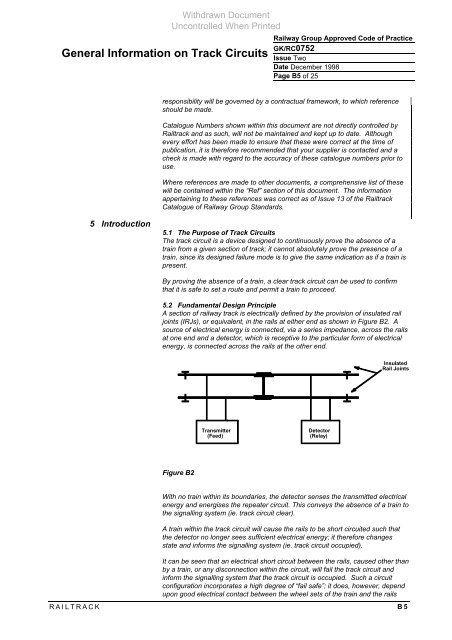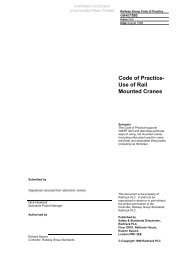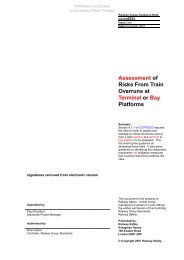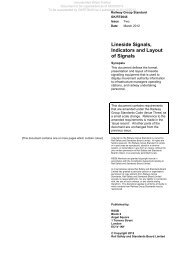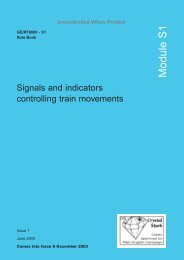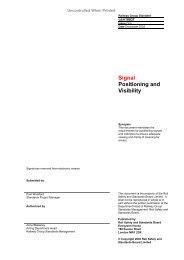General Information on Track Circuits - RGS Online
General Information on Track Circuits - RGS Online
General Information on Track Circuits - RGS Online
Create successful ePaper yourself
Turn your PDF publications into a flip-book with our unique Google optimized e-Paper software.
<str<strong>on</strong>g>General</str<strong>on</strong>g> <str<strong>on</strong>g>Informati<strong>on</strong></str<strong>on</strong>g> <strong>on</strong> <strong>Track</strong> <strong>Circuits</strong><br />
5 Introducti<strong>on</strong><br />
Withdrawn Document<br />
Unc<strong>on</strong>trolled When Printed<br />
Railway Group Approved Code of Practice<br />
GK/RC0752<br />
Issue Two<br />
Date December 1998<br />
Page B5 of 25<br />
resp<strong>on</strong>sibility will be governed by a c<strong>on</strong>tractual framework, to which reference<br />
should be made.<br />
Catalogue Numbers shown within this document are not directly c<strong>on</strong>trolled by<br />
Railtrack and as such, will not be maintained and kept up to date. Although<br />
every effort has been made to ensure that these were correct at the time of<br />
publicati<strong>on</strong>, it is therefore recommended that your supplier is c<strong>on</strong>tacted and a<br />
check is made with regard to the accuracy of these catalogue numbers prior to<br />
use.<br />
Where references are made to other documents, a comprehensive list of these<br />
will be c<strong>on</strong>tained within the “Ref” secti<strong>on</strong> of this document. The informati<strong>on</strong><br />
appertaining to these references was correct as of Issue 13 of the Railtrack<br />
Catalogue of Railway Group Standards.<br />
5.1 The Purpose of <strong>Track</strong> <strong>Circuits</strong><br />
The track circuit is a device designed to c<strong>on</strong>tinuously prove the absence of a<br />
train from a given secti<strong>on</strong> of track; it cannot absolutely prove the presence of a<br />
train, since its designed failure mode is to give the same indicati<strong>on</strong> as if a train is<br />
present.<br />
By proving the absence of a train, a clear track circuit can be used to c<strong>on</strong>firm<br />
that it is safe to set a route and permit a train to proceed.<br />
5.2 Fundamental Design Principle<br />
A secti<strong>on</strong> of railway track is electrically defined by the provisi<strong>on</strong> of insulated rail<br />
joints (IRJs), or equivalent, in the rails at either end as shown in Figure B2. A<br />
source of electrical energy is c<strong>on</strong>nected, via a series impedance, across the rails<br />
at <strong>on</strong>e end and a detector, which is receptive to the particular form of electrical<br />
energy, is c<strong>on</strong>nected across the rails at the other end.<br />
Figure B2<br />
Transmitter<br />
(Feed)<br />
Detector<br />
(Relay)<br />
Insulated<br />
Rail Joints<br />
With no train within its boundaries, the detector senses the transmitted electrical<br />
energy and energises the repeater circuit. This c<strong>on</strong>veys the absence of a train to<br />
the signalling system (ie. track circuit clear).<br />
A train within the track circuit will cause the rails to be short circuited such that<br />
the detector no l<strong>on</strong>ger sees sufficient electrical energy; it therefore changes<br />
state and informs the signalling system (ie. track circuit occupied).<br />
It can be seen that an electrical short circuit between the rails, caused other than<br />
by a train, or any disc<strong>on</strong>necti<strong>on</strong> within the circuit, will fail the track circuit and<br />
inform the signalling system that the track circuit is occupied. Such a circuit<br />
c<strong>on</strong>figurati<strong>on</strong> incorporates a high degree of “fail safe”; it does, however, depend<br />
up<strong>on</strong> good electrical c<strong>on</strong>tact between the wheel sets of the train and the rails<br />
RAILTRACK B5


